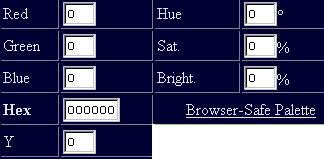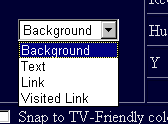TV-Friendly ColorPicker GuideMarch 24, 1999 A guide to the WebTV ColorPicker, an easy-to-use tool that will help you pick colors that display well on television. While computer monitors and televisions work through the same basic cathode ray technology, colors can appear dramatically different on each display. This is caused by several factors, including the general lower quality of the television hardware, and the composite signal that televisions receive.If Webmasters ignore these limitations, some colors and color combinations on their pages may distort when viewed on a television screen. The purpose of this tool and accompanying documentation is to help Webmasters identify problem colors and avoid them easily. While this help file gives some background regarding colors on television, readers more interested in the topic should read our article, Avoiding Color Distortion on Television, which investigates this topic in depth. The tool works by modifying individual colors as well as color combinations in an attempt to make them "TV-Friendly". While it is still possible to pick bad colors and combinations with this tool, the chances are greatly reduced. Selecting Colors Taking up most of the space on the screen are the color selection fields. There are two columns of fields, the left column containing RGB information, and the right containing HSB. The "Y" value from the "YUV" color model is on the bottom of the RGB column. The ColorPicker currently converts RGB to HSB and RGB to YUV, but only the "Y" field is displayed.
Entering data into any of these text fields will automatically cause all the other fields to update with fresh values. "Y" is the only field that you cannot manually change. And if you mis-type an entry, don't worry, the ColorPicker will find the closest usable value. Let's go into more detail about each one of these "color spaces", and how the ColorPicker represents it. RGB
HSB
YUV
Browser-Safe Colors Under the HSB selection fields, there is a link called "Browser-Safe Palette".
Clicking this will allow you to pick a color from the Netscape 216 browser safe color palette. Although these colors will not dither on a computer monitor, most of them are not "TV-Friendly". TV-Friendly colors are explained at the end of this document.
Selecting Text, Background or Link Colors On the left-hand side of the screen, there is a pull-down menu which allows you to modify the background, text, link or visited link color.
Color choices that you make in the selection fields will only affect the component that is selected in the pull-down menu. "TV-Friendly" Colors
Certain colors and color combinations may distort when viewed on a television. By checking the "Snap to TV-Friendly Colors" option, your color choices will be instantly checked and - if necessary - modified by the ColorPicker to display well on an NTSC television screen. Depending on your computer, the ColorPicker may take up to several seconds to make your color choices "TV-Friendly". If you find the tool too slow, consider changing colors with the "Snap To" option unchecked. When you have found a color combination you like, check the "Snap To" box, and the tool will find the closest "TV-Friendly" alternative. How Does It Work? The "Snap To TV-Friendly Colors" options works based on the principles described in our article, Avoiding Color Distortion on Television. These principles are:
Any color that you choose will show up immediately in the bottom frame. If you have "Snap To TV-Friendly Colors" checked, the ColorPicker will then attempt to ensure your background and text color choices will display properly on a television. Again, depending on your computer, this may take up to several seconds. Bugs Although this tool has been extensively tested, bugs may still exist. If you find what you believe to be a bug in the ColorPicker, please send an e-mail to the author.
|





